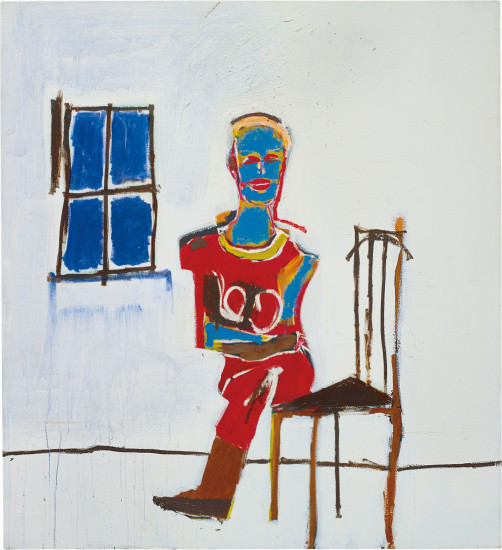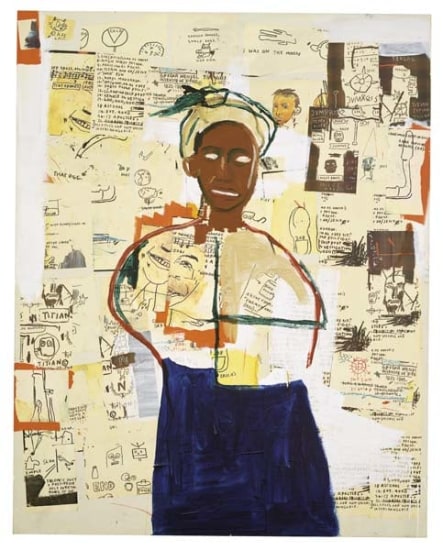Sold to Benefit The Bedari FoundationΟ ◆11Jean-Michel BasquiatBack of the Necksigned and dated 'Jean-Michel Basquiat 1982' lower right; further inscribed 'B.A.T' on the reverse screenprint with hand colouring on paper 127.7 x 257.8 cm (50 1/4 x 101 1/2 in.) Executed in 1982, this work is the bon à tirer before the edition of 24 plus 3 artist’s proofs. Full CataloguingEstimate £450,000 - 650,000 ‡ Place Advance BidContact Specialist Kate Bryan Specialist, Head of Evening Sale +44 20 7318 4026 kbryan@phillips.com
OverviewExemplifying Jean-Michel-Basquiat’s obsession with anatomical imagery on a monumental scale, Back of the Neck is one of several editioned silkscreens that the artist created in his lifetime. At the centre of the composition, a hand-painted gold crown hovers over a deconstructed torso. To the left, the titular words ‘back of the neck’ are inscribed in chalk-white over the surface’s dominating black ground, devised in Basquiat’s signature all-cap writing. The inclusion of this expression evidently refers to human anatomy; but also, as the foremost Leonardo da Vinci scholar Carlo Pedretti notes, to ‘the seat of the soul’.i Testament to its importance within Basquiat’s oeuvre, another example of Back of the Neck is held in the permanent collection of the Brooklyn Museum, New York, and another was included in the recent landmark exhibition Basquiat’s “Defacement”: The Untold Story, which took place at the Solomon R. Guggenheim Museum, New York, in 2019. It was in 1968, at the age of seven years old, that Basquiat first came in contact with the medical world. The young Basquiat was playing softball on his street in Brooklyn when he was hit by a car, resulting in a broken arm and various internal injuries. During his recuperation time in the hospital, his mother gave him a copy of the medical text Gray’s Anatomy, which he pored over and memorised. Filled with detailed anatomical drawings and diagrams, the book had a profound influence on the burgeoning artist who, throughout his oeuvre and particularly in his drawings and prints, has compulsively detailed fragments of the human body. His fascination with the anatomical realm was crystallised most compellingly in his first experimentation with printmaking, embodied by his two series Anatomy, 1982 and Untitled (from Leonardo), 1983. However, it is only in the present work, Back of the Neck, that Basquiat combined disparate limbs to create a complete image – one that would move beyond the isolated illustrations of medical textbooks. Illustration from Henry Gray’s publication Gray's Anatomy, 1918, lithograph plate, Mary Evans Picture Library, London. ©King's College London / Mary Evans Image: Mary Evans/Scala, Florence. A masterpiece hailing from Basquiat’s printmaking practice, Back of the Neck not only incorporates the artist’s sourcebook of signs – the writing, the anatomical sketches, the copyright symbol, the three-pointed crown – but furthermore boasts a fraught and taut energy that recalls the overarching sense of violence that invaded the air of New York City and the United States in the early to mid-1980s. Conceived the same year that the twenty-five-year-old black graffiti artist Michael Stewart was arrested and beaten to death while in New York police custody, Back of the Neck addresses the politics of violence surrounding the black body: the contortions, assaults and defacement it too often undergoes. Basquiat was obsessed ‘with the black male body’s history as property, pulverized meat and popular entertainment’, wrote Greg Tate. As a black artist, he was moreover acutely aware of ‘performing the splitting, doubling, and stitching-up procedures which lie behind a production of identity’.ii In Back of the Neck, the body is portrayed as inherently vulnerable -- its skeletal, brittle spine flanked by two dismembered arms; one almost entirely clad in flesh, the other flayed to muscle and sinew. The subject of the work appears to have been torn asunder, his body parts scattered across the paper. And yet, the figure remains crowned, like a fallen king or a martyr. A Critical Moment Executed in 1983, Back of the Neck furthermore cemented a moment of increased critical and commercial fame for Basquiat. A year prior, in March 1982, the artist was bestowed his first one-artist exhibition in the United States at the Annina Nosei Gallery, which spurred unanimous and near-unprecedented acclaim. A month later, the artist travelled to Los Angeles for another solo show, this time h
Sold to Benefit The Bedari FoundationΟ ◆11Jean-Michel BasquiatBack of the Necksigned and dated 'Jean-Michel Basquiat 1982' lower right; further inscribed 'B.A.T' on the reverse screenprint with hand colouring on paper 127.7 x 257.8 cm (50 1/4 x 101 1/2 in.) Executed in 1982, this work is the bon à tirer before the edition of 24 plus 3 artist’s proofs. Full CataloguingEstimate £450,000 - 650,000 ‡ Place Advance BidContact Specialist Kate Bryan Specialist, Head of Evening Sale +44 20 7318 4026 kbryan@phillips.com
OverviewExemplifying Jean-Michel-Basquiat’s obsession with anatomical imagery on a monumental scale, Back of the Neck is one of several editioned silkscreens that the artist created in his lifetime. At the centre of the composition, a hand-painted gold crown hovers over a deconstructed torso. To the left, the titular words ‘back of the neck’ are inscribed in chalk-white over the surface’s dominating black ground, devised in Basquiat’s signature all-cap writing. The inclusion of this expression evidently refers to human anatomy; but also, as the foremost Leonardo da Vinci scholar Carlo Pedretti notes, to ‘the seat of the soul’.i Testament to its importance within Basquiat’s oeuvre, another example of Back of the Neck is held in the permanent collection of the Brooklyn Museum, New York, and another was included in the recent landmark exhibition Basquiat’s “Defacement”: The Untold Story, which took place at the Solomon R. Guggenheim Museum, New York, in 2019. It was in 1968, at the age of seven years old, that Basquiat first came in contact with the medical world. The young Basquiat was playing softball on his street in Brooklyn when he was hit by a car, resulting in a broken arm and various internal injuries. During his recuperation time in the hospital, his mother gave him a copy of the medical text Gray’s Anatomy, which he pored over and memorised. Filled with detailed anatomical drawings and diagrams, the book had a profound influence on the burgeoning artist who, throughout his oeuvre and particularly in his drawings and prints, has compulsively detailed fragments of the human body. His fascination with the anatomical realm was crystallised most compellingly in his first experimentation with printmaking, embodied by his two series Anatomy, 1982 and Untitled (from Leonardo), 1983. However, it is only in the present work, Back of the Neck, that Basquiat combined disparate limbs to create a complete image – one that would move beyond the isolated illustrations of medical textbooks. Illustration from Henry Gray’s publication Gray's Anatomy, 1918, lithograph plate, Mary Evans Picture Library, London. ©King's College London / Mary Evans Image: Mary Evans/Scala, Florence. A masterpiece hailing from Basquiat’s printmaking practice, Back of the Neck not only incorporates the artist’s sourcebook of signs – the writing, the anatomical sketches, the copyright symbol, the three-pointed crown – but furthermore boasts a fraught and taut energy that recalls the overarching sense of violence that invaded the air of New York City and the United States in the early to mid-1980s. Conceived the same year that the twenty-five-year-old black graffiti artist Michael Stewart was arrested and beaten to death while in New York police custody, Back of the Neck addresses the politics of violence surrounding the black body: the contortions, assaults and defacement it too often undergoes. Basquiat was obsessed ‘with the black male body’s history as property, pulverized meat and popular entertainment’, wrote Greg Tate. As a black artist, he was moreover acutely aware of ‘performing the splitting, doubling, and stitching-up procedures which lie behind a production of identity’.ii In Back of the Neck, the body is portrayed as inherently vulnerable -- its skeletal, brittle spine flanked by two dismembered arms; one almost entirely clad in flesh, the other flayed to muscle and sinew. The subject of the work appears to have been torn asunder, his body parts scattered across the paper. And yet, the figure remains crowned, like a fallen king or a martyr. A Critical Moment Executed in 1983, Back of the Neck furthermore cemented a moment of increased critical and commercial fame for Basquiat. A year prior, in March 1982, the artist was bestowed his first one-artist exhibition in the United States at the Annina Nosei Gallery, which spurred unanimous and near-unprecedented acclaim. A month later, the artist travelled to Los Angeles for another solo show, this time h

.jpg)









Try LotSearch and its premium features for 7 days - without any costs!
Be notified automatically about new items in upcoming auctions.
Create an alert